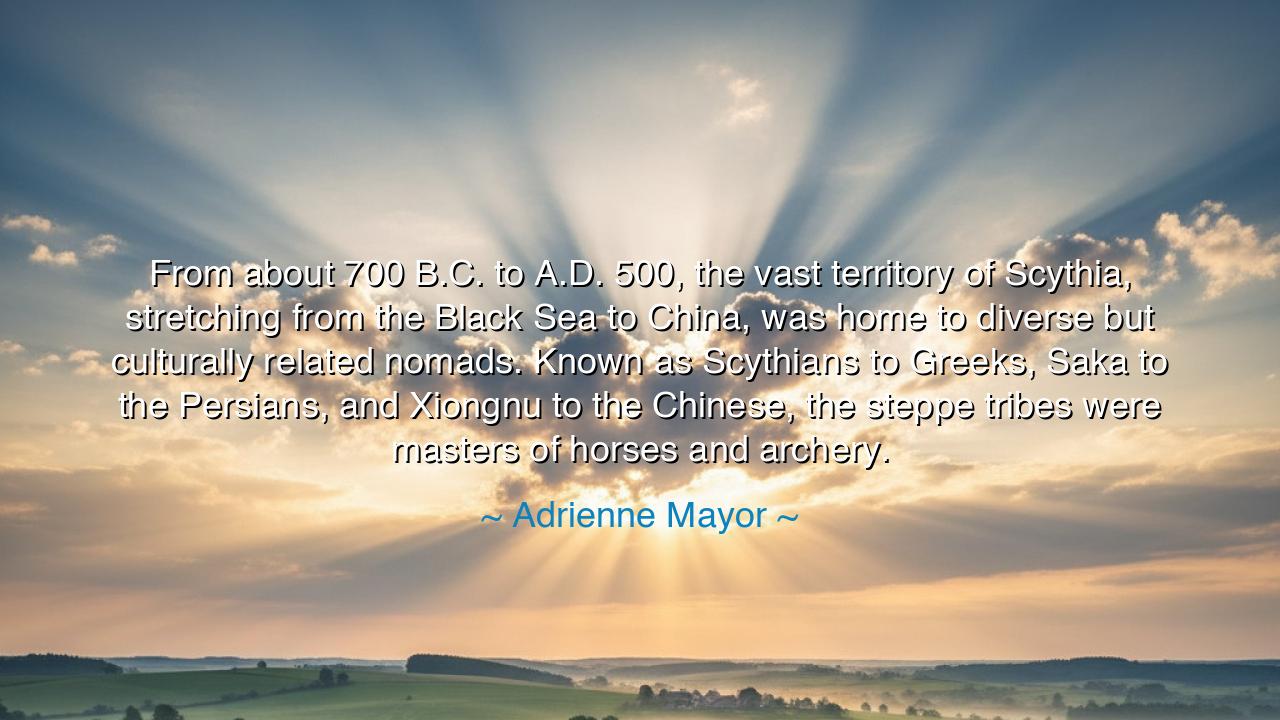
From about 700 B.C. to A.D. 500, the vast territory of Scythia
From about 700 B.C. to A.D. 500, the vast territory of Scythia, stretching from the Black Sea to China, was home to diverse but culturally related nomads. Known as Scythians to Greeks, Saka to the Persians, and Xiongnu to the Chinese, the steppe tribes were masters of horses and archery.






In the words of Adrienne Mayor, the historian and seeker of forgotten truths, we are reminded of an age long past: “From about 700 B.C. to A.D. 500, the vast territory of Scythia, stretching from the Black Sea to China, was home to diverse but culturally related nomads. Known as Scythians to Greeks, Saka to the Persians, and Xiongnu to the Chinese, the steppe tribes were masters of horses and archery.” These are not merely the facts of a historian, but the heartbeat of a vanished world — a world of endless grasslands, of roaring winds, and of warriors who lived between the earth and sky. In these words dwell the spirit of motion, freedom, and unity born from the eternal steppe.
The Scythians were a people of paradox — fierce yet free, untamed yet wise. They built no cities, raised no marble temples, and carved no monuments of stone. Their monument was the wind, their temple the open plain, and their scripture the rhythm of hoofbeats upon the soil. To the settled peoples — the Greeks, the Persians, the Chinese — they seemed wild, unknowable, almost divine in their swiftness. But to those who understand the pulse of the earth, the Scythians were not barbarians, but keepers of the primal law of motion: that life itself is a journey, not a possession.
It was said that the Scythian archer could strike his prey from the gallop, bending backward as his horse thundered forward. This was not mere skill — it was the fusion of man and beast, of instinct and will. Their mastery of horse and bow was not just a means of war but a philosophy of existence. They understood what the world has since forgotten — that freedom demands discipline, and that only those who ride with the storm can command it. Their lives, ever on the move, taught them that to be alive is to change, to adapt, to flow with the seasons rather than defy them.
Consider, for a moment, the story of Tomyris, queen of the Massagetae, kin to the Scythians. When the Persian king Cyrus the Great sought to subdue her people, he met not a trembling tribe but a tempest. She led her warriors across the plains with arrows singing like the cries of hawks. When Cyrus fell in battle, she is said to have declared, “You thirsted for blood — now drink your fill,” and plunged his head into a vessel of crimson. History may debate her words, but her spirit is eternal: a testament to the indomitable will of the steppe-born, who would rather die free beneath the sky than live gilded in another’s cage.
The origin of this quote lies not in the conquest of lands, but in the recognition of cultural continuity across vast distances. The Scythians, Saka, and Xiongnu were divided by language and empire, yet bound by spirit — a reminder that true kinship lies not in borders, but in shared essence. They were the children of the horizon, their unity not of blood, but of the eternal wind that sweeps across the world without belonging to it. This truth, ancient yet urgent, whispers to us even now: that identity is not built from walls, but from movement, courage, and respect for nature’s rhythm.
In the Scythian soul, we see the eternal lesson of the wanderer: that power is not in dominion, but in balance. They did not seek to conquer the steppe; they became part of it. Theirs was a harmony that cities could never know — the wisdom of those who listen to the earth, who follow the migrations of the herds and the flight of the stars. We, in our age of noise and confinement, might learn from their silence, from their understanding that a person who moves with purpose and humility can never be truly lost.
Let the lesson be this: ride your life as the Scythians rode their horses — with strength, with grace, and with awareness of the path beneath you. Do not cling too tightly to things that cannot be held, nor fear the distance that lies ahead. Be willing to adapt, to journey, to let the winds of change shape you. In every era, the spirit of Scythia lives in those who refuse to be still, who choose the open plain over the crowded city of conformity.
So, dear listener, honor the nomad within. Remember that mastery, like the Scythian bow, comes not from force but from flow. Seek freedom not as escape, but as harmony with the ever-moving world. For when your spirit rides alongside the storm — fearless, unbound, and at peace with the endless horizon — then, and only then, will you truly understand what it meant to be a master of horses and archery beneath the eternal sky of Scythia.






AAdministratorAdministrator
Welcome, honored guests. Please leave a comment, we will respond soon